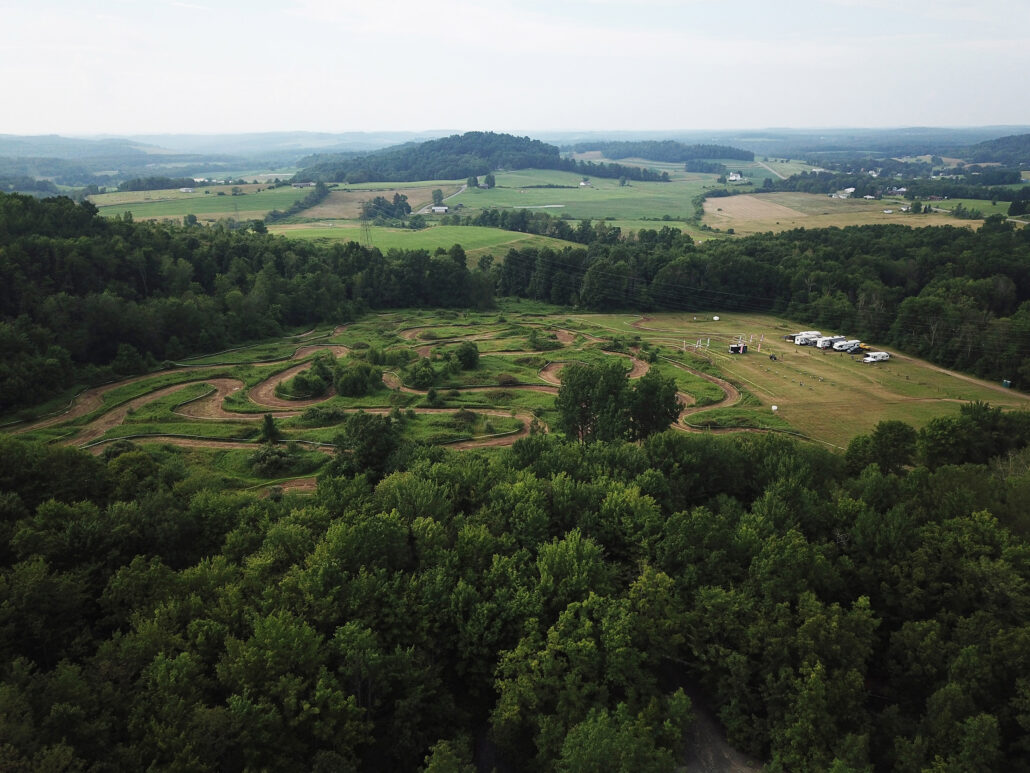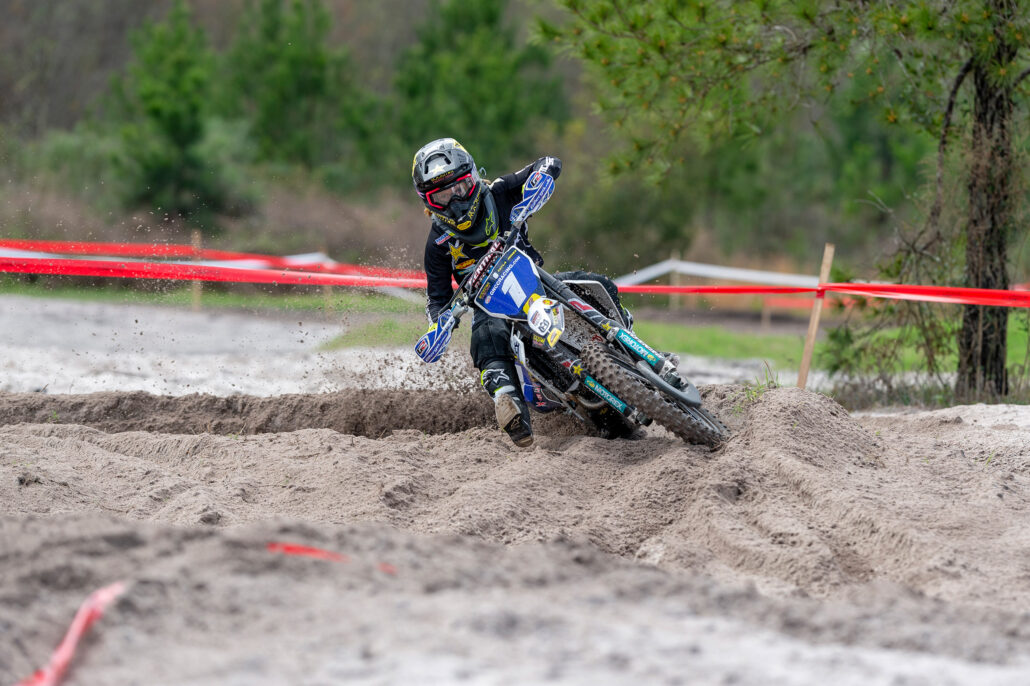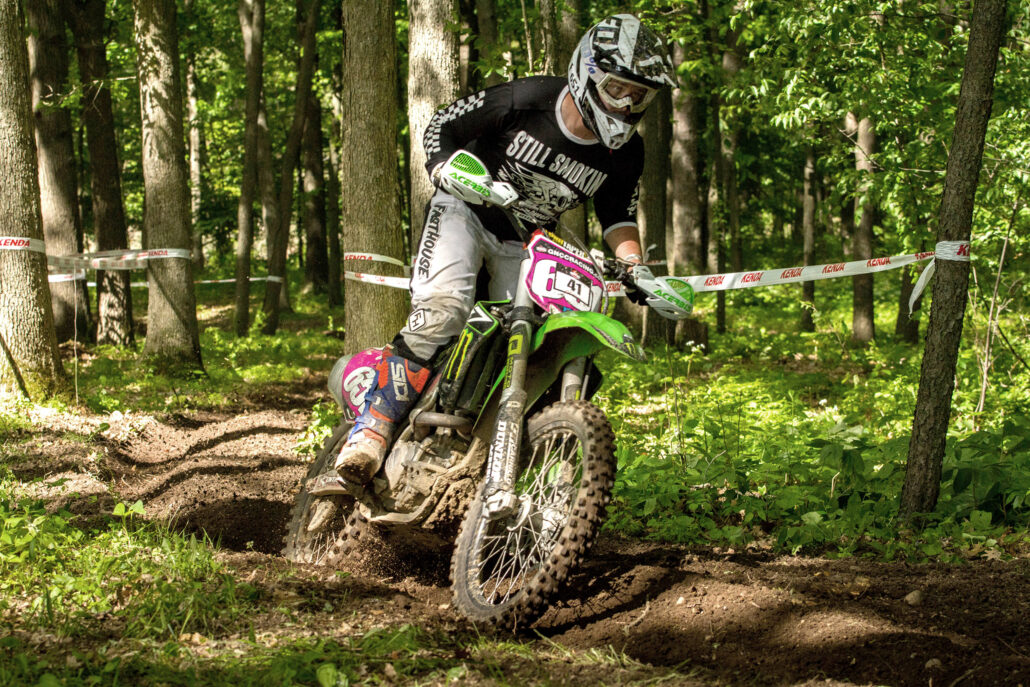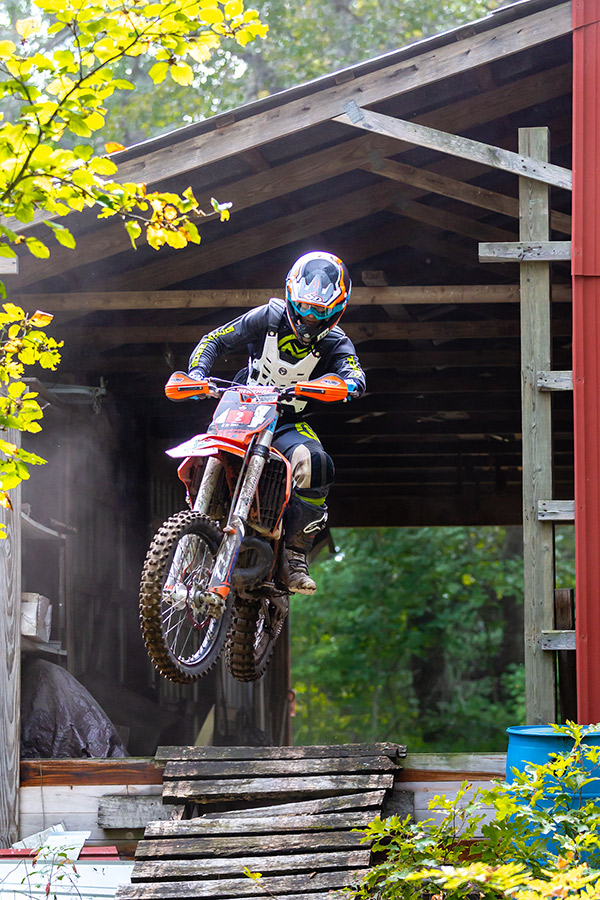AMERICAN MOTORCYCLIST April 2020
Sprint Enduros: Bred for Speed
Woods Racing For Everyone

By Michael Marino
Sprint enduro competition draws elements from the AMA National Enduro series, but follows a format inspired by the International Six Days Enduro, providing intense, action-packed events in which each rider completes a series of tests in a timed format.
Not surprisingly, sprint enduros are among the events that serve as qualifiers for the U.S. ISDE teams each year.
A sprint enduro is not just a shortened version of a traditional enduro. Rather than emphasizing the endurance demanded by longer-established off-road events, including hare and hound races or hare scrambles, riders in sprint enduros focus on posting fast times for relatively shorter test sections.
The format is exciting and accessible. It’s great for new off-road racers and allows clubs and organizers to host off-road competition events with a lot less land and volunteer power.

Sprint enduros take the traditional enduro race-against-the-clock format and compress it into two or more short tests, with breaks between tests.
So how does a sprint enduro work?
Sprint enduros pit racers against the clock—similar to traditional enduros—but compress competition into two or more tests that are several miles long each.
Erek Kudla, the AMA’s off-road racing manager, said sprint enduro participants ride through each test section two or more times with breaks between runs.
Class winners are determined by riders’ cumulative times for all test runs.
Competitors are released into each test section individually, often by class. Faster classes are allowed to go first, so riders don’t have to worry about being overtaken on the course.
All competitors—regardless of competition class or skill level—ride the same tests.
Organizers sometimes set up tests that feature challenging terrain. But they often offer a less technical, but longer, optional route around the tough section.
Full Gas Sprint Enduro founder and promoter Jason Hooper said his series uses two tests—one grass track and one enduro-style course—that riders tackle three times each day of competition. Tests are between 3 miles and 5 miles long.
If riders crash or have mechanical problems, the time spent repairing the machine and getting back on track counts against them.
Hooper also said the start and finish are close to one another, bringing riders back to the paddock, where they can hydrate and refuel and work on their bikes.
“You don’t need to worry about keeping time or running out of gas,” Hooper said.
The AMA District 37 Sprint Enduro Series is working toward standardizing the test format, said Nick Stover, D37 competition committee member.
Most of the events feature three tests, with one being a more technical layout for intermediate and advanced riders only.
The varying number of tests is inspired by the desert racing format, where riders compete in races of different length, based on their skill level. Each test is about 3 to 8 miles long. Competitors ride each test twice.
Logan Densmore, chairman of the AMA Michigan Sprint Enduro Series, said his series uses two tests and varies the number of times riders take each test, depending on the distance of each test.
The AMA D37 and Michigan series are similar to the Full Gas series with regard to timing and scoring.

Most sprint enduros feature at least two tests on two or more types of terrain.
A trending format
All three series started with one-off events in the 2010s and have grown into multi-round series that attract hundreds of entries.
Hooper said his first Full Gas event took place in 2014. He based his series design on his experience covering the ISDE and off-road racing in Europe. He noticed that countries doing well at the ISDE had racing series that used a format similar to the Six Days’ short tests. That gave him the idea to develop a similar series in the United States.
Hooper said the Full Gas series has enjoyed consistent growth since it started. It averages 320 entries at events, and its 2020 season opener set a series record with 492 entries.
The first event for the Michigan series took place in October 2017. Densmore said he competed at several Full Gas events and drew inspiration from the their format. He estimated the Michigan series has averaged about 225 riders per event.
Stover said the D37’s involvement also began in 2017, with a one-off event put on by the United MC. The series started the next year with two rounds and grew to eight rounds for 2019. Stover estimated the rounds draw an average of 240 riders each.
Who competes?
While “enduro” is in the series name, organizers say that the majority of riders don’t come from enduro backgrounds.
Hooper and Densmore said many of their riders come from a hare scrambles or motocross background. On the West Coast, Stover said, D37 draws many of its riders from the ranks of off-road grand prix and hare and hound series.
Hooper noted that it can be hard to get traditional enduro enthusiasts who enjoy endurance competition to give the sprint format a try.
All three series organizers said one of the biggest draws is the camaraderie that the format breeds. Because there’s usually a half-hour or more between tests, riders get to know each other while spending time in the pits. This helps develop friendships—and sometimes friendly rivalries–among competitors that keep them coming back for more.
Another reason the format may be growing is how much easier it is to find a suitable location and staff for a sprint enduro than other off-road formats.
Kudla said a traditional enduro requires a 75- to 100-mile route. Such an expansive course requires dozens of people to operate it.
By comparison, a sprint enduro needs a total of seven to 13 miles of routing and can be operated by 20 or fewer people.
“With the loss of access to public lands in the western United States and problems getting enough landowners to allow an organizer access in the East, traditional enduros are getting harder to stage,” Kudla said. “Sprint enduro allows an organizer or club to operate an enduro-style competition within about the same land area that is needed for a hare scramble.”
Hooper said Full Gas has operated events on areas as small as about 100 acres, but typically uses 200 to 300 acres for its tests and paddock.

The sprint enduro format is great for new riders and attracts competitors from a variety of other racing disciplines.
Sprint enduro and the ISDE
The rise of sprint enduro in America correlates with the country’s newfound success in ISDE competition.
The Full Gas series got its start in 2014, and the United States has since won two ISDE World Trophy titles, a Women’s World Trophy title and a Club division championship.
Kudla said having series that use an ISDE-style sprint format helps develop athletes that are trained for short bursts of speed instead of approaching off-road competition with an endurance mentality.
Stover said grand prix riders tended to do better at the D37 sprint enduros compared to the desert racers, which he attributed to the different mentalities it takes to succeed in those disciplines.
Desert racing features two grueling loop routes that can take most of the day to complete. Off-road grand prix uses a shorter, 45-minute format that’s more akin to the “go fast right now” approach sprint enduro requires.
The qualifier system for the U.S. ISDE Club teams features several rounds hosted by AMA-sanctioned sprint enduro series throughout the nation. The qualifiers are no longer one-off events that use an ISDE sprint format. They often are part of regular competition series that feature riders who have the opportunity to compete in similar events throughout the year.
Get Started In Sprint Enduro Racing
Two of the best aspects of sprint enduros are they’re great for new and experienced off-road competitors alike, and they don’t require a lot of modifications to a typical off-road bike.
Kudla said the short tests, the option of stopping and easily returning to the paddock if you don’t feel comfortable and the reduced chance of getting taken out by another rider make sprint enduros ideal for those who would like to give off-road competition a try.
The short tests mean rider fitness isn’t as much of an issue as it is in other disciplines. You do not have to be in peak shape to perform well in the short tests. Plus, there’s time between tests to catch your breath and drink fluids.
Motorcycles designed or prepped for traditional enduro competition need few, if any, modifications to compete, and the sport provides motocrossers with a great alternative format to compete in between motocross rounds.
One tire vendor reported selling more 19-inch rear tires (a size more typical of a motocross machine) at Full Gas events than any other off-road event he worked.
The mix of test types makes sprint enduros an opportunity for competitors to round out their off-road riding skillset. The most well-rounded riders tend to perform best at AMA District 37 sprint enduros.
It’s not enough to be fast at one kind of test. Riders need to be fast over groomed track surfaces, as well as over tree roots and rocks.
Fast facts
Events last one or two days and feature two or more test sections that competitors ride multiple times.
Each section is usually 3-8 miles in length, with a mix of enduro/woods and grass track.
Competitors are released into each test one at a time and race against the clock.
No timekeeping. Tests start when a group/class is called to staging.
Riders can stop whenever they want and not be many miles from staging.
All skill levels ride the same tests.
A rider’s perspective
Chadler Gregg is a sprint enduro racer who competed in hare and hound and off-road grand prix events before giving sprint enduro a try in 2018.
The 22-year-old from Hesperia, Calif., said the event format is what keeps him coming back. He’s raced in the 96-200cc B and 201-250cc B classes in West Coast sprint enduro events.
“You finish all of your tests in about five hours, and the start area is right near the finish,” he said. “It’s great for people who want to watch you race.”
He said the start is usually viewable, and it’s often easy for spectators or family to make their way to various places around the tests to watch the action.
AMA-sanctioned sprint enduro series/events
Full Gas Sprint Enduro Series, an AMA Regional Championship
WORCS Sprint Enduro Series
AMA District 37 Sprint Enduro Series
Michigan Sprint Enduro Series
Trail Pros Sprint Cross Country Series
Arizona Motorcycle Riders Association
Southern Enduro Riders Association

